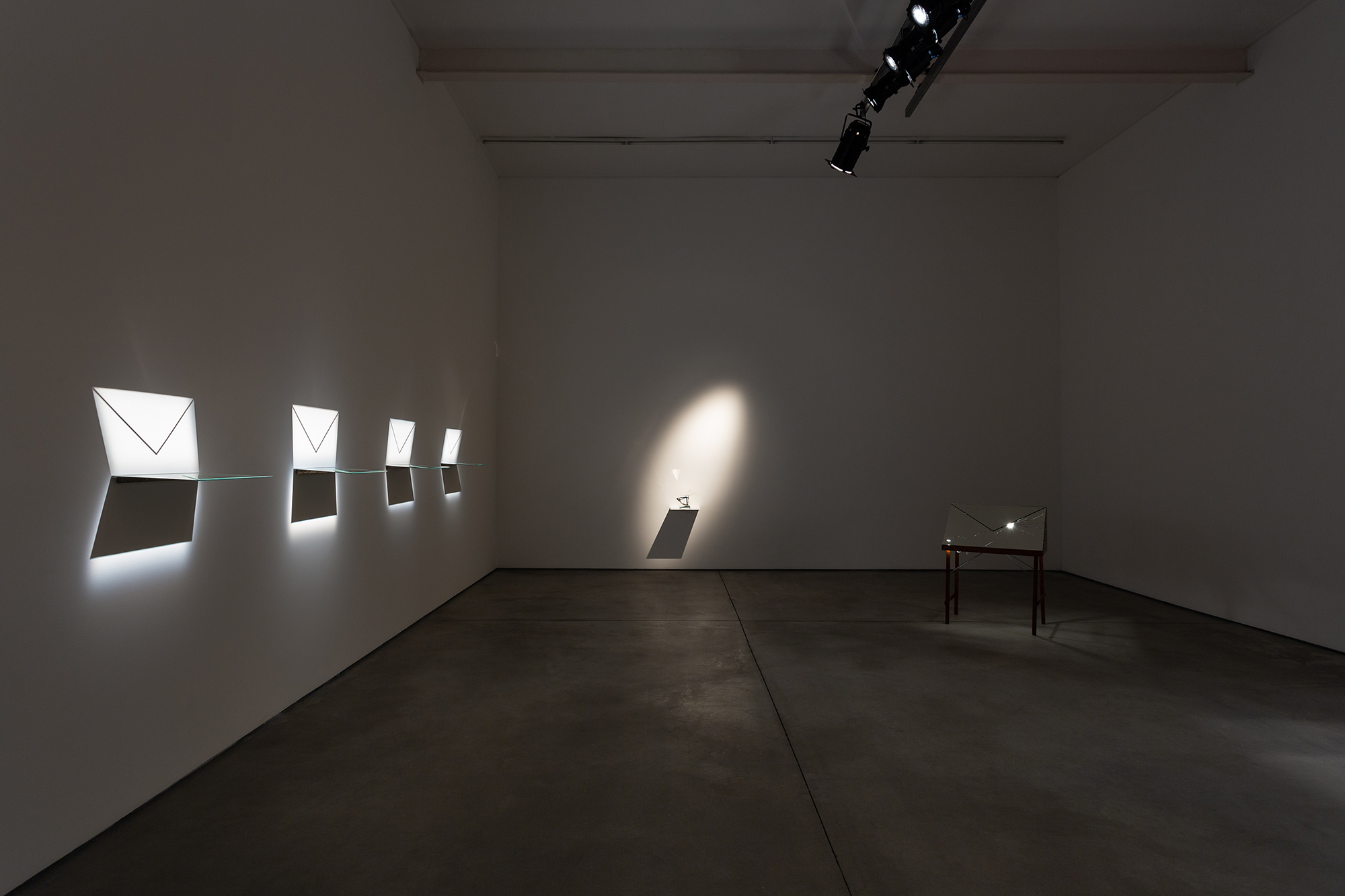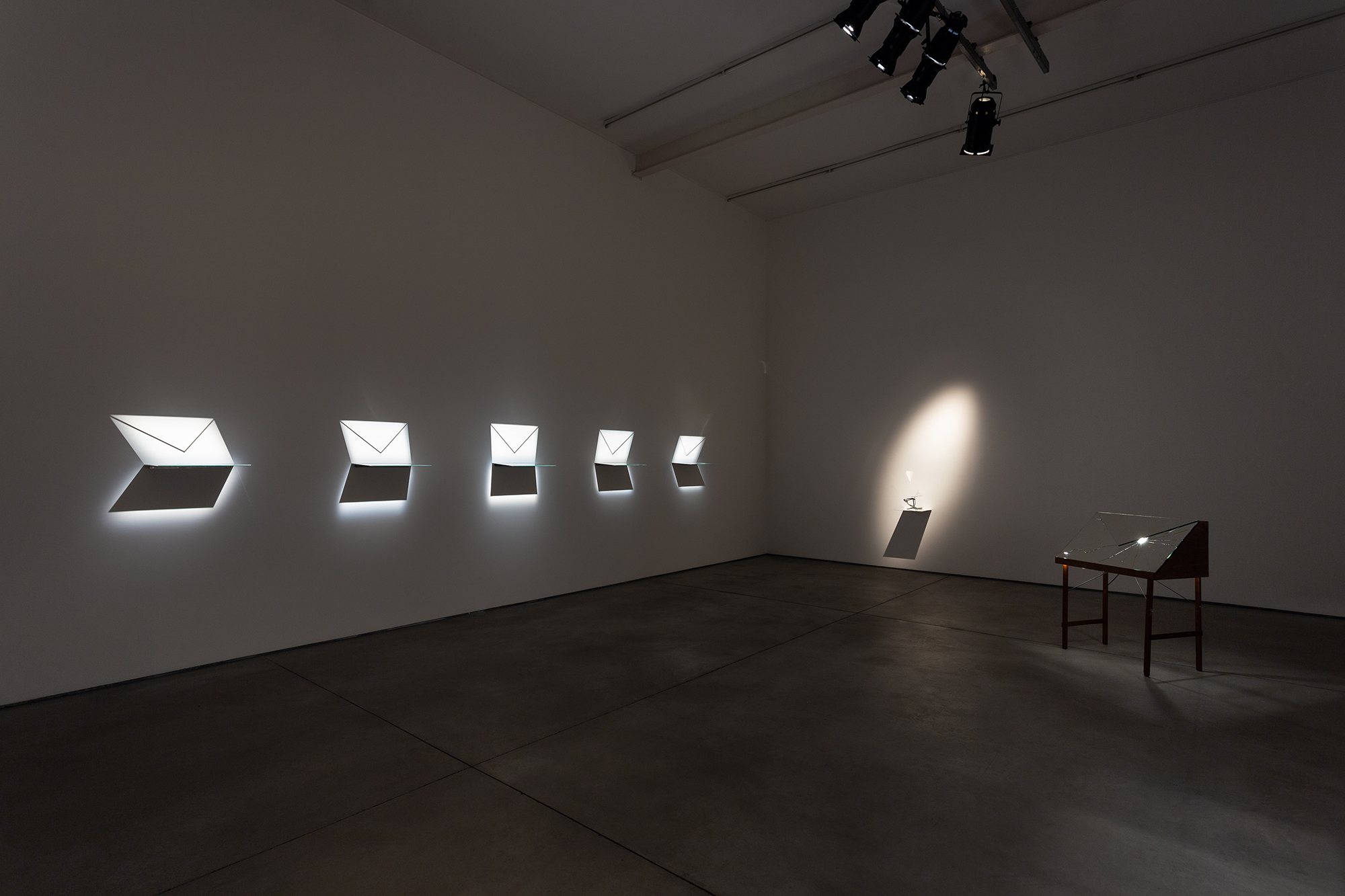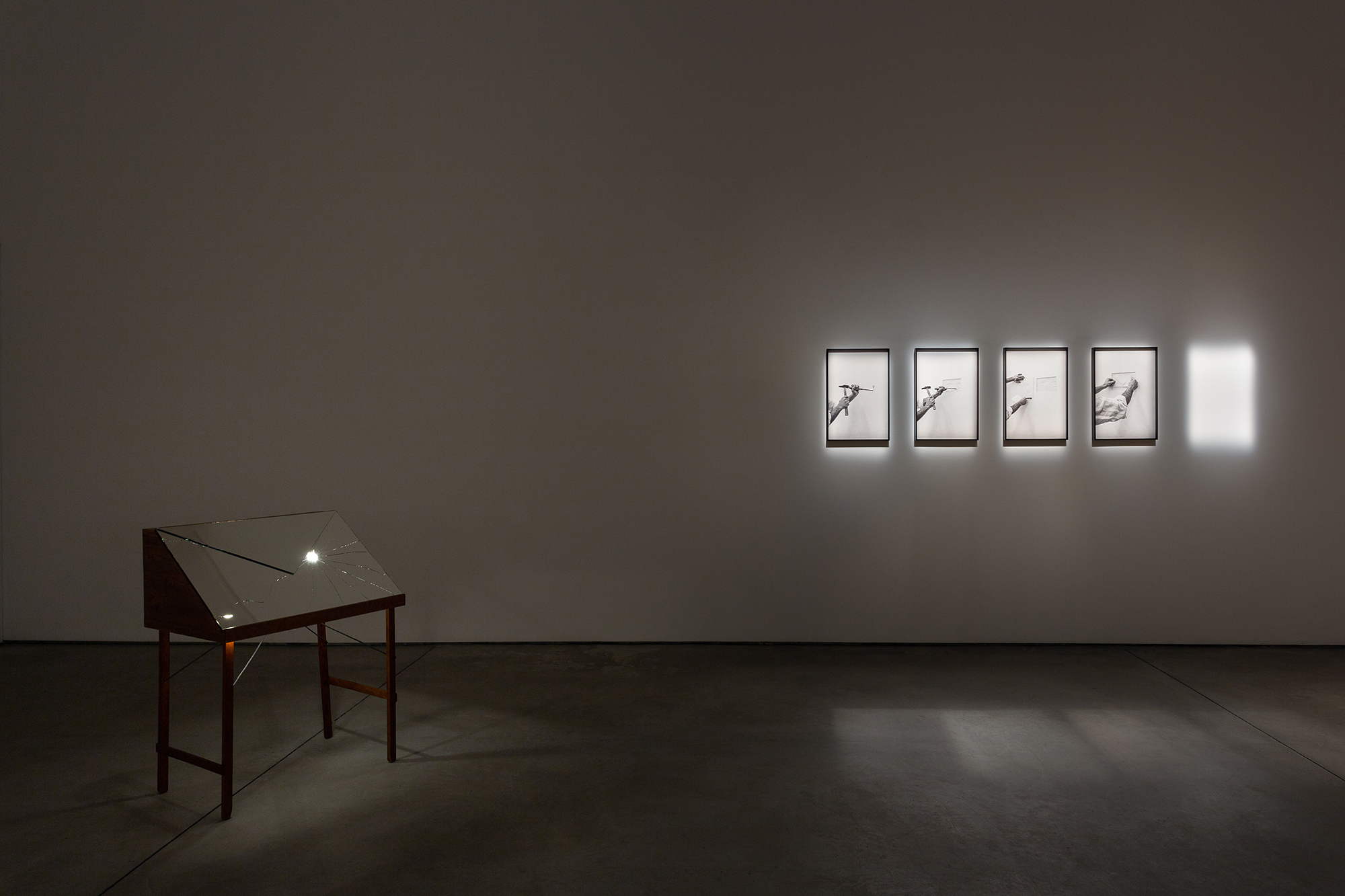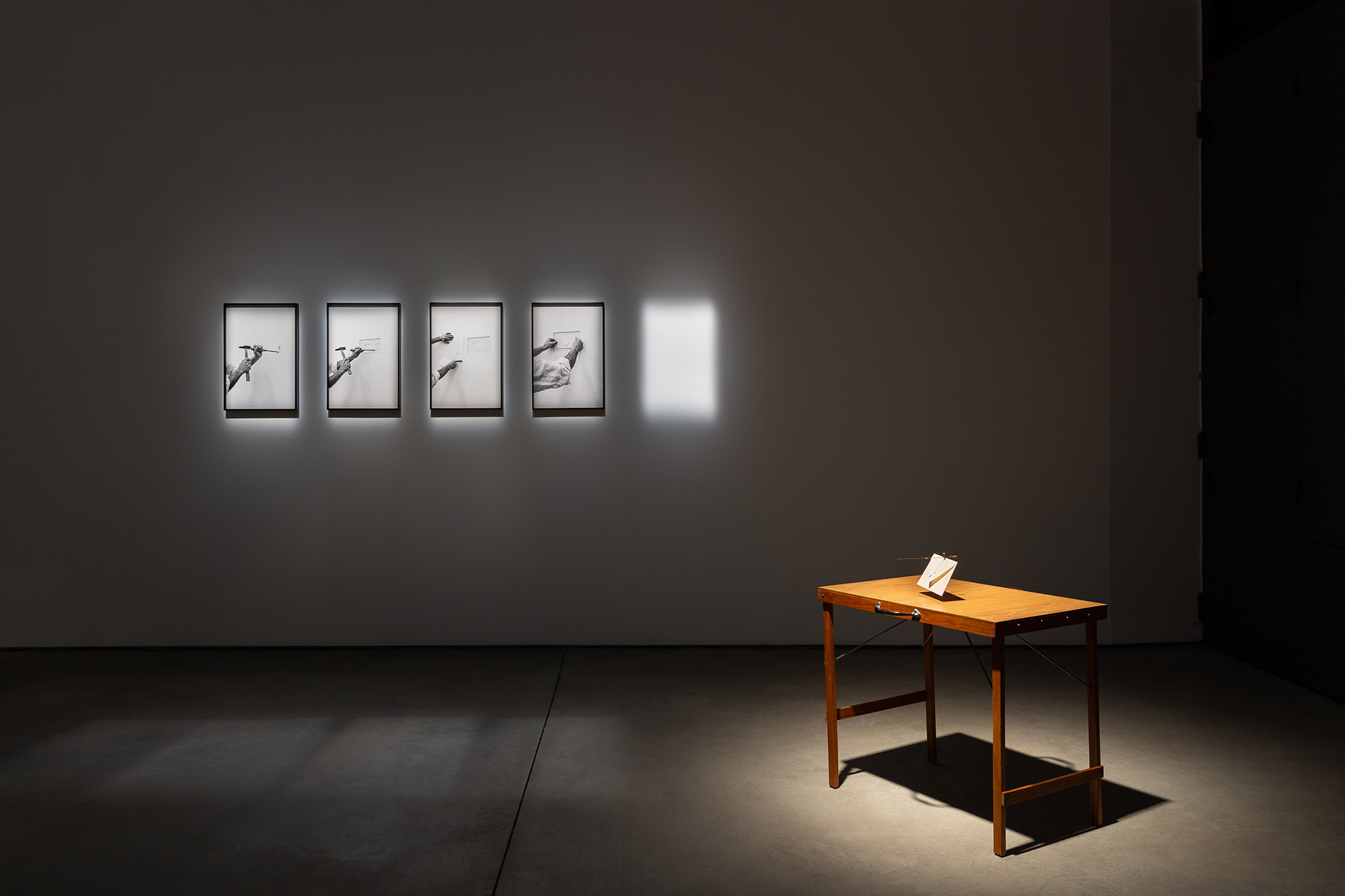Words don't come easy - Galeria Bruno Múrias. 2022
Words don’t come easy (ENG)
Galerias Bruno Múrias. Lisbon, 2022.
A word is only a skin,
A thin film of human lots,
And any line in your poem
Can sharpen the knife of your fate.[1]
The return is necessary, it is the eternal path, without an end. Everything that happens, happens because of an invisible point or line drawn in the past – it is thus the only present time. The year is 1994, the piece 9 days 140 km. Rui Calçada Bastos (Lisbon, 1971) presents a slide of the mountains of Tibet sealed inside a tracing paper envelope, superimposed over a light box on the wall of an old warehouse in the port area of Lisbon. It is the first time that this rectangular image with pinpointed edges appears in his work, unconsciously deciding on a motto that would forever be present in his œuvre. A new encounter follows in 1999, in the video Rendez–vous, where a letter slides under a door and an anonymous figure receives it, only to discover its empty interior. During the following decades, the motif was subtly incorporated into varied works and media, appearing in painting (in the series Correspondences with...), in video (in the installation Return to Sender) and in sculpture (Moi et Toi – Ne pas séparer les mots d’une syllabe). We may well intuit, as in an internal and constant leitmotiv, the key moment of this memory – both personal and materialized – if we return to that missive of a master – When we are just an empty envelope the making is without vertex – like the path of water. Think about it.[2]
Words don’t come easy marks Rui Calçada Bastos’s third solo show at the gallery and, compiled from a profoundly intimate and reflective gesture, it also marks what is the culminating moment of the meeting of the idea of envelope and correspondence in the artist’s work – whether it being the object itself or merely its suggestion. The absence of answers is mirrored in the author himself, and the hesitation inherent in the seeker is evident in the exhibition’s luminous limbo, as well as in the ethereal, almost levitational quality that some of the works present. In an attempt to decode this presence in his imaginary, the search for a truth that coincides with the genesis of this ghost is clear, whose aura quality runs through the artist’s installation and sculpture – which simultaneously shows and hides from itself. This unveiling and veiling, language and silence, intrinsically symbolise the evidence of life and death – the experience of a message whose content is illuminated in the clearing – thus, the disclosure of the apparently sealed truth.[3]
Let us begin by approaching each work individually, in the humble hope of being able to outline the sensitive path that determines this exhibition. Love letter, love letter, go tell her, go tell her, homonymous for the chorus of Nick Cave’s Love Letter, presents us with the transparency of five envelopes born from a possible reflection between a mirror and a light. In fact, we could say that it is only one envelope, a secret materialized in five moments of its movement mapped in a half-moon, sometimes declining, sometimes rising, here possibly as the hand of a clock, caught in a loop of temporal precision. This clarity, whose metaphysical awakening guarantees nothing but a certainty in its encounter, slowly illuminates the remaining peripheries of the gallery. We are then guided to Heavy Weightlessness, a sculpture that introduces language into the exhibition. The verses Still is the unspoken word / the word unheard [4]read mirrored inside the envelope that lightly rests upon an old post office scale. Inspired by T.S. Eliot’s Ash Wednesday, these words precede the conclusion of the excerpt, which performs Where shall the word be found, where shall the word / Resound? Not here, there is not enough silence[5]. By reflecting on the (material) weight of the word as a (spiritual) decisive moment, the artist summons up the haptic condition of the poetics of a gesture in oblivion – even suppressed. Recalling a classic author, spoken words are the signs of the soul’s experiences, and written words are the sign of spoken words.[6]
Punctuating two ends of this timeless writing room are two sculptures whose bases derive from old travelling salesman’s tables, often used as portable bases for writing correspondence. In one of them, North, an ajar envelope is suspended, crossed by the verticality of a standing compass that points directly at the viewer, who is looking at it
from the front. Returning to his perpetual chain of self-referential perspectives (which are as much his own as the gaze of those who confront the work) the artist raises, in a final instance, an orientational device whose direction is both different – varying according to its position – and permanent – always indicating who is facing it. There may exist, in this enigma masquerading as certainty, an immediate relation with the second work originating from these moveable tables, Bullet Point. Flickering from a distance, a small, blinding light similar to that of a lighthouse in the darkness of the night at sea, reflects the spectator’s face when approaching the surface that emanates it – a mirror with the outline of a letter, shattered and yet gleaming. Curiously facing the direction of the previous evoked north, both contain their decipherment in the moment (image) of reflection – the bullet point is then announced – There is a crack, a crack in everything / That’s how the light gets in.[7]
There is also a last moment in this secret room of messages and lights, the final declaration of an act of complicity and union. Four photographs record an immutable gesture, the sealing of a letter inside the gallery wall. Inside it, a message – There are no walls between us. The artist thus claims the decisive vulnerability in the relationship between the artist and the work, as much as between the artist and the spectator. Reiterating the permanence of the honesty of ideas, of unshakeable certainties – or, we could even say, of the apex in which we find ourselves – this exhibition grants us only a post scriptum: we are sealed in silence, the invisible link that unites us – and nothing more.
I hold this letter in my hand
A plea, a petition, a kind of prayer
I hope it does as I have planned…[8]
Eva Mendes
[1] Tarkovsky, Arseny, The Word, I Burned at the Feast: Selected poems of Arseny Tarkovsky, Cleveland State University Poetry Center, 2015
[2] Morais, Pedro, missive delivered to the students of At.(re) – Atelier livre
[3] Heidegger, Martin, The Origin of the Work of Art, Edições 70, 2020
[4] Eliot, T.S., Ash Wednesday, T.S. Eliot Collected Poems 1909-1962, Faber and Faber, 1963
[5] Ibidem.
[6] Aristotle, On Interpretation, Marquette University Press, 1962
[7] Cohen, Leonard, Anthem, Columbia Records, 1992
[8] Cave, Nick, Love Letter, Nick Cave The Complete Lyrics 1978-2013, Penguin Books, 2013
_____________________________________________________________________________________________________________________________________________________
Words don’t come easy (PT)
Galeria Bruno Múrias, Lisboa 2022
A word is only a skin,
A thin film of human lots,
And any line in your poem
Can sharpen the knife of your fate.[1]
O retorno é necessário, é o caminho eterno, sem fim. Tudo o que acontece, acontece devido a um ponto ou linha invisível desenhado no passado – ele é, assim, o único tempo presente. O ano é 1994, a obra 9 dias 140 km. Rui Calçada Bastos (Lisboa, 1971) apresenta um diapositivo das montanhas do Tibete selado dentro de um envelope de papel vegetal, sobreposto a uma caixa de luz na parede de um antigo armazém da zona portuária de Lisboa. É a primeira vez que esta imagem retangular e de extremidades rebatidas pinaculares surge no seu trabalho, decidindo inconscientemente um mote que ficaria para sempre presente na sua obra. Um novo encontro sucede-se em 1999, no vídeo Rendez-vous, onde uma carta desliza por debaixo de uma porta, e uma figura anónima a recebe, apenas para descobrir o seu interior vazio. Durante as décadas seguintes, o motivo foi subtilmente incorporado em obras variadas, surgindo em pintura (na série Correspondências com…), em vídeo (na instalação Return to Sender) e em escultura (Moi et Toi – Ne pas séparer les mots d’une syllabe). Poderemos bem intuir, como num interno e constante leitmotiv, o momento-chave desta memória – tanto pessoal quanto materializada – se regressarmos àquela que foi a missiva de um mestre – Quando somos apenas envelope vazio o fazer é sem vértice – como o caminho da água. Pensem nisso[2].
Words don’t come easy marca a terceira exposição individual de Rui Calçada Bastos na galeria e, compassada a partir de um gesto profundamente intimista e reflexivo, assinala também aquele que é o momento de reunião culminante da ideia de envelope e de correspondência no trabalho do artista – seja este o objeto em si ou apenas a sua sugestão. A ausência de respostas espelha-se no próprio autor e a hesitação inerente àquele que procura está evidente no limbo lumínico da exposição, bem como na qualidade etérea, quase levitacional, que algumas das obras apresentam. A fim de uma tentativa de descodificação desta presença no seu imaginário, é clara a busca de uma verdade que coincida com a génese deste fantasma cuja qualidade da aura atravessa a instalação e a escultura do artista – que simultaneamente se mostra e se oculta de si mesma. Este desvelamento e velamento, linguagem e silêncio, simbolizam intrinsecamente a evidência de vida e de morte – a experienciação de uma mensagem cujo conteúdo se ilumina na clareira – o desocultar da verdade aparentemente selada[3].
Comecemos por abordar cada obra individualmente, na humilde esperança de conseguirmos delinear o trajeto sensível que determina esta exposição. Love letter, love letter, go tell her, go tell her, refrão homónimo de Love Letter de Nick Cave, apresenta-nos a transparência de cinco envelopes que nascem de um reflexo possível entre um espelho e uma luz. Na verdade, poderemos dizer que se trata apenas de um envelope, um segredo materializado em cinco momentos do seu movimento mapeado em meia-lua, ora em declínio, ora em ascensão, aqui possivelmente enquanto ponteiro de um relógio, preso num loop de nitidez temporal. Esta clareza, cujo despertar metafísico não garante senão uma certeza no seu encontro, ilumina vagarosamente as restantes periferias da galeria.
Somos então guiados para Heavy Weightlessness, uma escultura que introduz a linguagem na exposição. Os versos Still is the unspoken word / the word unheard[4] lêem-se espelhados no interior do envelope que repousa levemente sobre uma antiga balança de correio. Inspiradas por Ash Wednesday de T.S. Eliot, estas palavras antecedem a conclusão do excerto, que perfaz Where shall the word be found, where shall the word / Resound? Not here, there is not enough silence[5]. Ao refletir sobre o peso (material) da palavra enquanto momento (espiritual) decisivo, o artista convoca a condição háptica da poética de um gesto em esquecimento – até mesmo suprimido. Relembrando um autor clássico, spoken words are the signs of the soul’s experiences, and written words are the sign of spoken words[6].
Pontuando duas extremidades desta intemporal sala de escrita, encontram-se posicionadas duas esculturas cujas bases nascem de antigas mesas de caixeiro-viajante, utilizadas amiúde enquanto bases portáteis para o redigir de
uma correspondência. Numa delas, North, um envelope entreaberto encontra-se suspenso, atravessado pela verticalidade de uma bússola de pé que aponta diretamente para o espetador que a contempla de frente. Retornando à sua perpétua cadeia de perspetivas auto-referenciais (que são tanto de si como do olhar de quem confronta a obra) o artista ergue, em instância última, um dispositivo de norte, cuja direção é tanto diferente – variando consoante a sua posição – quanto permanente – indicando sempre quem se encontra à sua frente. Existirá possivelmente, neste enigma mascarado de certeza, uma relação imediata com a segunda obra originária destas mesas móveis, Bullet Point que, à distância cintilando uma pequena, ofuscante luz semelhante à de um farol na escuridão da noite em mar, reflete o rosto do espetador aquando da aproximação da superfície que a emana – um espelho com contornos de uma carta, estilhaçada e, contudo, reluzente. Curiosamente encarando a direção do anterior norte evocado, ambas contém a sua decifração no momento (imagem) de reflexão – o bullet point é então anunciado – There is a crack, a crack in everything / That’s how the light gets in [7].
Existe, ainda, um último instante neste quarto secreto de mensagens e luzes, a declaração final de um ato de cumplicidade e união. Quatro fotografias registam um gesto imutável, o selar de uma carta no interior da parede da galeria. Dentro dela, uma mensagem – There are no walls between us. O artista reclama, assim, a vulnerabilidade decisiva na relação entre o artista e a obra, tanto quanto entre o artista e o espetador. Reiterando a permanência da honestidade de ideias, das certezas inabaláveis – ou, poderíamos ainda dizer, do vértice em que nos encontramos – esta exposição concede-nos apenas um post scriptum: estamos selados no silêncio, o elo invisível que nos une – e nada mais.
I hold this letter in my hand
A plea, a petition, a kind of prayer
I hope it does as I have planned…[8]
Eva Mendes
[1] Tarkovsky, Arseny, The Word, I Burned at the Feast: Selected poems of Arseny Tarkovsky, Cleveland State University Poetry Center, 2015
[2] Morais, Pedro, missiva entregue aos alunos do At.(re) – Atelier livre
[3] Heidegger, Martin, A Origem da Obra de Arte, Edições 70, 2020
[4] Eliot, T.S., Ash Wednesday, T.S. Eliot Collected Poems 1909-1962, Faber and Faber, 1963
[5] Ibidem.
[6] Aristóteles, On Interpretation, Marquette University Press, 1962
[7] Cohen, Leonard, Anthem, Columbia Records, 1992
[8] Cave, Nick, Love Letter, Nick Cave The Complete Lyrics 1978-2013, Penguin Books, 2013



